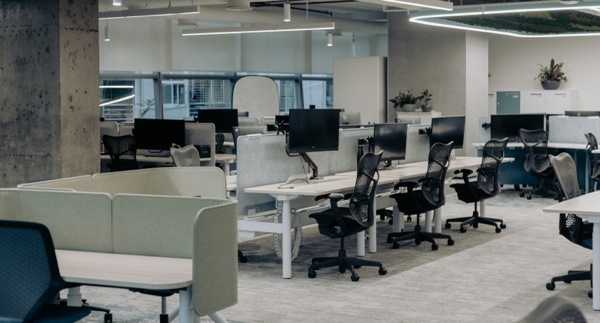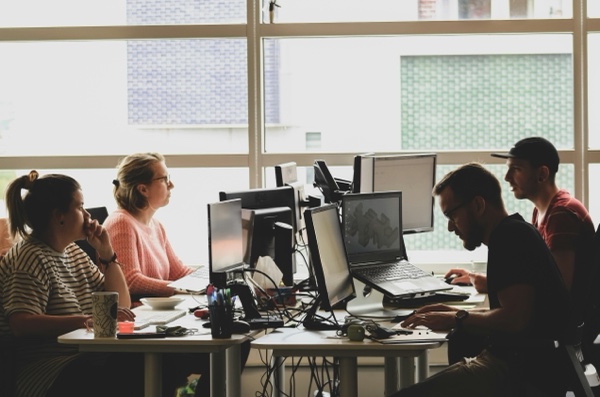
Hot desking hasn’t exactly lived up to the hype.
Originally introduced as a flexible, cost-saving solution, it became the go-to answer during the pandemic when hybrid work took over. Employers hoped it would help reduce office footprints, support flexibility, and bring structure to a new way of working.
But for many organisations—especially those with open-plan layouts—it brought something else: friction.
Employees have found themselves wandering offices looking for a seat, adjusting unfamiliar equipment, or settling for noisy spots that make focus nearly impossible. In some cases, hot desking has become the very reason people prefer to stay home.
Still, that doesn’t mean hot desking is broken. It just needs to be done intentionally. When paired with the right tools, spaces, and policies, hot desking can support how people work today, without all the chaos.
Let’s take a step back and look at where hot desking came from, how it evolved during hybrid work, and where it makes the most sense today.
The Rise of Hot Desking
While the concept of shared desks has been around since the 1990s, COVID-19 supercharged its adoption. In a world suddenly built around remote work and rotating schedules, having a desk for every employee no longer made financial—or spatial—sense.
 According to the Chartered Institute of Personnel and Development
According to the Chartered Institute of Personnel and Development (CIPD), flexible seating adoption increased by nearly 60% between 2020 and 2023 in UK-based organisations. In the US,
Gensler’s 2022 Workplace Survey found that 52% of hybrid employees returned to offices with some version of desk sharing.
Crucially, technology enabled this rise.
Modern desk booking apps and office sensors made it easier to manage who sits where each day. During the pandemic, many organizations rolled out desk reservation systems as they downsized space.
One global real estate firm found that the typical ratio has shifted to 1.5 people per desk in hybrid offices (versus about 1.1 per desk in 2019), as companies bet on not everyone showing up at once.
By late 2024, two-thirds of companies were planning to reduce office space by >25% within 18 months, and a majority were implementing unassigned seating as part of that
strategy. In sum, hot desking became viewed as
the perfect complement to hybrid work: it promised flexibility for employees and cost savings for employers.
But the promise of flexibility came with unintended consequences.
What Doesn’t Work: Hot Desking Pitfalls and Backlash
When open-plan offices met hot desking, the results were… mixed.
Despite its cost benefits, hot desking has a bad reputation with many employees, and for good reason. Poorly implemented hot desking can lead to
productivity losses, stress, and plummeting morale. We looked at several research studies that highlight several common pain points, and here is what we found:
Lost Sense of Belonging and Lower Morale
Humans have an inherent need to claim a space and feel a sense of belonging at work. Taking away personal desks can undermine that. Employees can’t keep family photos, favourite coffee mugs, or other personal touches that make a workspace feel like “home.”
“Humans have a deep-rooted inherent need for belonging and this needs to be present in our places of work” - Sonya Dineva
Occupational psychologists note that having to clear your desk each day prevents people from identifying with their environment and satisfying that need for belonging. Over time, this can make the office feel cold and impersonal. It’s no surprise that surveys consistently link hot desking to drops in morale.
In
one poll,
8 in 10 office workers said that flexible seating arrangements – including hot desking harmed their mental wellbeing.
Even a major UK union,
Unison, cautioned that while hot desking is supposed to break down barriers, it can i
solate staff and hinder the building of colleague relationships. Employees might not see the same neighbours each day, making it harder to form team camaraderie.
Without careful planning, the “modern, flexible office” can start to feel like a hotel lobby where everyone is a stranger. This erosion of belonging and social connection directly hits employee morale.
 Stress and “Desk Anxiety”
Stress and “Desk Anxiety”
The daily scramble for a workspace can become a genuine source of stress. Employees may worry each morning about whether they’ll find a suitable desk or if they’ll be stuck in a far-off corner. There’s even a term for this preoccupation – “hot desk anxiety” – referring to the nervousness some feel about securing a spot each day.
Research confirms that this is a widespread issue: in a review of dozens of studies,
a top complaint among employees was the stress of not knowing where they’ll sit.
“Simply trying to find a desk first thing can be a task in itself - especially for those who arrive later after having dropped children at school or nursery" - Christina McAnea ”
The uncertainty can start the day off on the wrong foot, especially if people feel they must arrive extra early just to claim a decent desk. Employees with certain personalities or needs (for example, those who are more introverted or who have social anxiety) can find the constant change deeply unsettling. When not managed well, hot desking can introduce a daily undercurrent of anxiety that harms overall
job satisfaction and well-being.
Productivity Hits and Time Wasted
Another side effect of poorly planned hot desking is a drop in productivity. Simply put, moving around has overhead costs. Instead of walking into an office and getting right to work, employees might spend significant time each day
hunting for a desk and setting up their equipment.
One study found that hot-deskers spent on average
18 minutes every day just looking for a workspace and getting settled.
Over a week, that’s a sizeable chunk of time lost.
Academic research has similarly observed this inefficiency: employees in non-assigned seating environments report losing time adjusting monitors, chairs, and other tools to their liking,
repeating setup tasks that permanent desk users only do once. Beyond the wasted minutes, constantly readapting to a new spot can impose cognitive load. People have to reorient themselves, locate coworkers or office resources, and mentally adjust to different surroundings.
If the hot-desking policy is poorly designed – say, not enough desks for peak days or lack of convenient equipment – frustrated employees may spend more time fiddling with setup or searching for colleagues than doing productive work. In short, any gains in space efficiency can be undermined by losses in employee efficiency.
A
2023 survey found “
not enough desks” was among the top reasons (1 in 5 workers) gave for avoiding the office on high-traffic days. This is not a good sign for companies that want to have a successful RTO.
Lack of Control and Other Hidden Costs
A frequent gripe in hot-desking offices is the loss of personal control and privacy. Workers often can’t choose who they sit next to, and noise or interruptions can vary day to day. A literature review by
Public Health England noted that a
low sense of control over one’s workspace (as in many hot desk setups) is associated with higher levels of stress and even increased sick days.
Some employees feel they are “nomads” in their own office, which can be exhausting. Additionally, without assigned seating, teams might scatter, making quick face-to-face coordination harder (ironically undermining the collaboration that hot desking was supposed to enhance).
There have also been reports of “desk hogging” behaviors – for instance, people staking out a preferred desk by leaving items there, which can lead to conflicts. All these factors illustrate that
hot desking isn’t a cure-all.
Hot desking done wrong can be disastrous for both morale and performance. Companies have learned this the hard way. Some high-profile firms that eagerly embraced hot desking during the pandemic have since backtracked.
For example, in 2024, tech giant
Salesforce reversed course and brought back assigned desks for certain teams after a wave of complaints – employees said the all-hot-desk office felt too impersonal and made it harder to get work done.
Ripping away everyone’s assigned desk without a thoughtful strategy is a recipe for stress, chaos, and backlash. So, does that mean hot desking is inherently doomed? Not necessarily.
Hot desking can work – even thrive – but only under the right conditions.
Where Hot Desking Makes Sense
Hot desking is not universally bad; in the right context, it can be a
smart solution. The key is knowing when and where it truly fits. Research and real-world experience suggest a few scenarios where hot desking tends to shine:
- Coworking Spaces and Shared Offices
Coworking spaces have long proven that hot desking can succeed as a
core model. In a coworking environment, individuals from different companies or freelancers come and go, using the space on an as-needed basis. Having assigned desks would defeat the purpose – instead, these spaces thrive by offering a variety of unassigned tables, booths, and lounges that anyone can use. The result is a highly efficient use of space: desks rarely sit idle for long when a constant flow of members is rotating through. This model has grown tremendously in the past decade.
By the end of 2024, there are projected to be around
42,000 coworking locations worldwide – each one essentially powered by the concept of shared, on-demand desks. The
community vibe of coworking is enhanced by hot desking, as people bump into new faces and cross-pollinate ideas. For companies looking to provide employees with occasional office access without maintaining their own big office, coworking hot-desks are a popular solution. It’s a scenario where the flexibility of not having an assigned seat is a clear positive, not a drawback.
- Project-Based or Highly Mobile Cultures
Hot desking also works well in organisations where employees are
frequently out of the office or regrouping into new teams. Consulting firms are a great example. Consultants might spend most of their week at client sites or travelling, so on any given day, a large portion of them aren’t in HQ. It makes little sense in that case for everyone to have a permanently assigned cubicle sitting empty.
Deloitte, for instance, embraced hot desking in their Amsterdam office “The Edge,” installing about
1,000 desks for 2,500 employees and grouping workspaces into neighbourhoods instead of individual offices. The assumption was that at any time, many of those 2,500 people would be out meeting with clients or working remotely – a ratio that proved accurate. Similarly, industries like software development or creative agencies often organise around projects: teams form, disband, and re-form with new people.
Flexible seating lets staff easily sit near whoever they’re collaborating with that week. When a project ends, folks simply move on to where they’re needed next, without anyone “owning” a desk that ties them down. In these dynamic environments, hot desking supports agility.
Activity-Based Working (ABW) is often implemented alongside it, providing specialised zones (quiet focus areas, collaboration zones, etc.) that employees can switch between.
The common thread is a culture where mobility is high and the workforce values flexibility over permanence. In such cultures, hot desking feels natural and can indeed boost teamwork and
space efficiency at the same time.
Technology to the rescue
What turns hot desking from a potential free-for-all into a smooth operation? The answer is smart
technology and design. Companies that successfully hot-desk typically lean on a few key tech tools to reduce chaos and keep people happy:
- Door Tablet Desk Booking Application: Employees can view floor maps, filter by location or amenities, and reserve desks on demand on any browser. Door Tablet BOOKER removes morning uncertainty and helps employees book near teammates or in quiet zones. With calendar integration and real-time updates, easy to navigate, fast, and removes desk anxiety before it starts.
- Door Tablet SQR: Door Tablet’s Workplace Signage Touch Display Mounted directly at each desk, it clearly shows if a seat is available or taken, so you never waste time searching. Your employees can tap the device to instantly reserve their chosen spot or check in
- Smart Wayfinding and Space Navigation: Large offices? Multiple floors? No problem. Instantly provide employees with an overview of available rooms or desks.
The overarching goal is to make a hot-desk office as convenient as a permanent desk setup. The more friction you remove (by using tech to, say, indicate which desks have a monitor available, or by providing easy tools to reserve a desk in a quiet area when needed), the more employees can concentrate on work rather than logistics.
In essence, technology can turn hot desking from a potential headache into a relatively frictionless experience by providing structure, information, and adaptability that static offices never needed.
It’s not the end of Hot-desking
Hot desking, when stripped down to its essence, is just a tool. It can create space for flexibility and collaboration, or it can lead to daily headaches and disengagement. What makes the difference isn’t the lack of assigned seats, but the presence of structure, support, and intentional design.
In the end, it’s not the desk that matters most. It’s how you make people feel when they show up to use it.